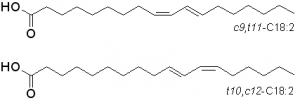Natural fatty acid CLA may have mild fat loss and muscle gain benefits, but research is conflicting.

- Promoting fat loss. CLA may be able to boost fat oxidation, reduce fat accumulation, or increase calories burned.
- Supporting muscle mass. CLA may decrease muscle protein breakdown associated with exercise.
Overview
Conjugated linoleic acid (CLA) is a fatty acid compound similar to linoleic acid naturally present in the dairy and meat products of certain plant-eating animals. As an isomer, CLA has the same molecular formula as linoleic acid but different structure. CLAs include as many as 28 different isomers, but thus far researchers have only identified two potentially useful ones – c9t11 (cis-9, trans-11) and t10c12 (trans-10, cis-12).
Ninety percent of dietary CLA comes in the c9t11 form, with an average American diet estimated to supply 151-215 mg CLA daily. Most CLA supplements, on the other hand, mix c9t11 and t10c12 at a 1:1 ratio and are produced synthetically from linonelic acid present in safflower oil.
Early petri dish and animal research of CLA showed potential benefits for obesity and other conditions. As a result, CLA has become a popular ingredient in weight loss supplements and sports formulas that advertise the simultaneous loss of fat and maintenance or growth of muscle during exercise. Despite this, the findings of human trials have been been mixed.

How CLA Might Help PWO Formulas
Due to the conflicting results of human trials, the mechanisms by which CLA might help exercise remain unclear. However, researchers suggest several possibilities:
Potential increase of fat oxidation
Several animal and human studies report that CLA results in increased fat oxidation – an enhanced usage of fat for energy. One of the ways it achieves this could be by stimulating carnitine palmitoyl transferase, an enzyme involved in fatty acid oxidation. 2
Potential reduction of fat accumulation
Another popular hypothesis is that CLA may reduce the accumulation of fat in fat cells by inhibiting lipoprotein lipase, an enzyme which promotes fat storage.3
Potential modulation of energy expenditure and metabolic rate
It’s also possible that CLA may somehow increase the body’s energy expenditure or metabolic rate, resulting in more calories being burned. But as with other mechanisms, research is inconclusive and often conflicting.
Potential inhibition of compounds that promote protein breakdown
One of the main theories for how CLA might preserve or increase muscle mass is by reducing the breakdown of protein, particularly as a result of exercise. For example, it may down-regulate the activity of tumor necrosis factor-alpha, a proinflammatory signaling molecule that promotes muscle protein catabolism (breakdown).
CLA’s Proposed Benefits
As a pre-workout supplement, CLA is advertised as a way to increase fat loss and preserve or grow muscle mass. However, human research findings of these benefits are conflicting.
Some studies show that CLA is indeed capable of promoting fat loss with or without exercise, while others report no effect. Similarly, studies that combined CLA with resistance training report mixed results, with some showing improved fat loss, strength, and muscle gains, and others reporting no effect.
All things considered, researchers propose that CLA may have a modest fat loss benefit even in people of normal weight, but its effects on muscle mass require further study.4
Research
Animal Research
Animal studies of CLA report promising findings such as reduced body fat, increased muscle mass, and enhanced endurance exercise capacity. Specific findings indicate that CLA may:
- Boost muscle growth in endurance-trained mice, but also increase damage caused by oxidative stress5
- Improve endurance exercise performance in mice by promoting fat oxidation67
- Decrease body fat and increase muscle mass in the absence of exercise8
Human Research
The positive results of animal CLA studies spurred a large number of human trials. Thus far however, their findings have been mixed.
CLA (1.8 g) may promote fat loss in exercising, normal-weight individuals
This randomized, double-blind study was one of the first to explore whether CLA can increase fat loss achieved through exercise. Twenty healthy, normal weight-people (BMI 25<) performed a 90 minute workout three times a week while taking placebo or CLA (1.8 g) daily for 12 weeks. CLA resulted in significant fat loss, reducing body fat from an average of 21% to 17%, compared to no change for placebo.
- The researchers concluded that “CLA reduces body fat but not bodyweight in healthy exercising humans of normal body weight“9
CLA (6 g) does not appear to affect body composition or strength in resistance-trained men
This randomized, double-blind study was one of the first to test whether CLA can enhance fat loss, strength, and muscle growth when combined with resistance training. Twenty-three men with resistance training experience were assigned to take placebo or CLA (6 g) daily for 4 weeks while continuing their usual weight-training program. CLA did not significantly affect the changes in body mass, fat-free mass, muscle strength, or any other parameters.
- The researchers concluded that “CLA supplementation did not significantly affect gains in bench press or leg press/hip sled 1RM. These findings suggest that CLA supplementation does not appear to possess significant ergogenic value“10
In this double-blind study, 69 people with at least 1 year of resistance training experience were randomly assigned to take whey protein (45 g), creatine (9 g) plus protein (36 g), or creatine (9 g) plus CLA (6 g) plus protein (36 g) daily. They followed this protocol for 5 weeks while performing strength training 6 days a week. The CLA group had the greatest improvements in bench-press (16.2% vs 9.7% average for other two groups) and leg press (13.1% vs 7.7%) strength. CLA also gained more lean tissue mass than the other two groups combined (2.4% vs 1.3%).
- The researchers concluded that “the addition of CLA to creatine and protein resulted in enhanced strength improvements and lean-tissue mass with high-volume strength training in well-trained young adults“11
CLA (5 g) may slightly enhance fat loss and muscle hypertrophy when undergoing resistance training
Seventy-six participants were randomly assigned to placebo or CLA groups (5 g/day) for 7 weeks while undergoing resistance training 3 days a week. In addition, 17 of the participants crossed over to the opposite group for a further 7 week trial. The researchers measured various markers of strength, protein metabolism and body composition before and after the study began. They found that the CLA group had a larger increase in lean tissue (+1.4 kg vs +0.2 kg for placebo), larger fat loss (-0.8 kg vs +0.4 kg for placebo), larger increase in bench press strength in men, and a smaller increase of 3MH, a marker of muscle protein breakdown.
- The researchers concluded that “CLA has small effects for decreasing fat mass and increasing lean tissue mass. Although these effects were statistically significant, the clinical significance is most likely quite small“12
CLA (3 g) does not appear to reduce body fat in healthy women
The goal of this frequently-cited, single-blind study was to see if the findings of reduced body fat in animal trials of CLA could be reproduced in human participants. Seventeen healthy women were randomly given placebo or CLA (3 g) daily for 64 days while their diet and activity were held constant to help produce accurate results. There was no significant difference between CLA and placebo in terms of body fat percentage, fat mass, fat-free mass, body weight, fat oxidation, and energy expenditure.
- The researchers concluded that “consumption of a CLA mixture at 1% of calories had no significant effect on body composition or energy expenditure in healthy women after 64 d of intervention.These results are in marked contrast to previous animal studies“13
Dosage for Pre-Workout
- According to research, 5-6 g appears to be the ideal dose to achieve both the fat loss and muscle mass benefits
- CLA is rarely used in pre-workout formulas; standalone supplements typically come in 1 g capsules, taken 3 times daily
Side Effects
CLA is not associated with any significant side effects even with large, continuous daily doses (6 g).14 Although some animal studies found that CLA may increase exercise-induced oxidative damage and negatively impact liver and kidney function, human trials found no evidence of these effects.
Supplements in Review Recommendation
- CLA, 5-6 g daily, made from safflower oil.
If fat loss is one of your main exercise goals, then CLA could be a useful pre-workout supplement. Although human trial results don’t stack up well against the large benefits seen in animal research, CLA most likely has mild fat loss benefits, and could possibly help you maintain or grow muscle while exercising.
The 5-6 g dose appears to be safe and sufficient to elicit benefits. Five-six grams is the dose used by studies that managed to improve both fat loss and muscle mass. Moreover, research shows that taking 6 g daily for a year is completely safe.
References
Leave a Reply